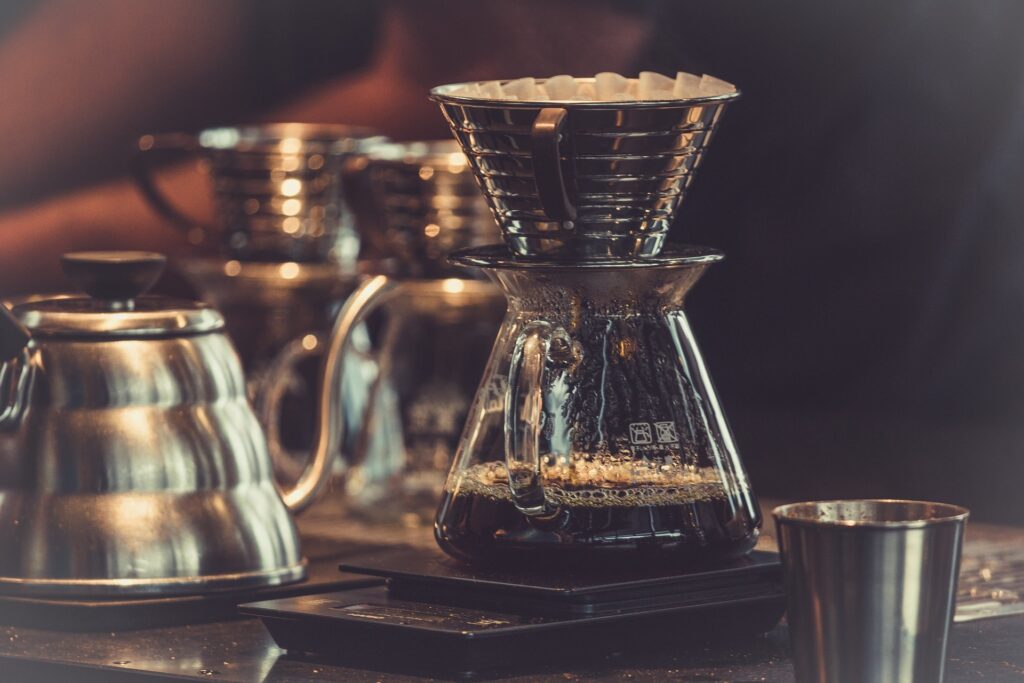
Coffee Brewing Methods
The humble coffee bean is one of the most versatile ingredients on the planet. A single bean from a specific country and farm can be brewed in many different ways with varying techniques to unlock the hundreds of diverse and distinct flavours, textures and aromas that are locked away inside the roasted coffee bean.
To help you learn about the versatility of coffee beans, this post will share with you several different brew methods and divulge into the when, how, why surrounding these skills and techniques that open the door to a complex and fascinating world of making coffee. And by the end, we hope this will help you understand and identify the most convenient, enjoyable and tasty way to make a delicious cup of coffee that suits you.
The Bloom
Throughout this journey through history and the many different brewing methods that have been invented along the way, we will be explaining the varying techniques used to brew coffee.
Amongst these instructions there will be a recurring use of the term ‘bloom’, to put it simply this term is the fast release of gas that occurs when hot water comes into contact with coffee grounds.
You can visually see this reaction occurring as little bubbles will appear and pop all across the coffee grounds once saturated in water. To bloom your coffee you must pour between 30g-60g of water evenly across your coffee grounds at the start of your brew, or less scientifically pour boiling water until the coffee grounds are submerged.
This is important for your brew to taste the best it can, as without this process the gas will be releasing throughout the extraction and this prevents certain flavours and aromas from being extracted from the coffee grounds creating a flat and sometimes lifeless cup of coffee.
Tip: Brewed coffee consists of 90% water, therefore we recommend you try and use the best water possible. You will be amazed by the contrast in quality between filtered and unfiltered water. With the prior creating a clean, complex and vibrant cup of coffee whereas the former can often mask many flavours and aromas in a cup of coffee. A simple and cheap charcoal stick does a great job filtering water for your morning brew.
Espresso
The Espresso coffee machine was invented in 1884 by Angelo Moriondo, however, it didn’t take off in popularity until the early 20th Century. This big breakthrough came with
Achille Gaggia’s invention, which used a large lever, compressing a spring which when released, creates a large amount of pressure forcing boiling water through the coffee.
The end result was a small, strong and well-extracted cup of coffee which used a far finer grind size than any other brew method. Today, we can see a dramatic improvement in the knowledge, coffee equipment and techniques used in brewing espresso shots, resulting in a coffee that can be complex, full-bodied and sweet. And has now shaped the foundation for each new wave of coffee that has passed over recent years, and is the most popular and primary method of brewing for coffee shops of all different styles and quality around the world.
Forming the basis for a wide variety of many consumers’ favourite drinks from an intense macchiato to a silky smooth latte.
Just a word of warning to anyone who is interested in using the espresso machine to make your morning coffees at home, making a great espresso requires dedication, attention to detail, and consistency.
But if a new hobby interests you the effort is always worth it. The espresso shot is a combination of pressure and resistance, as the speed at which the water flows through the coffee determines how much flavour is extracted. This is why grind size is pivotal to the process producing your desired tastes and results.
If your grind is too fine then the water will struggle to pass through the bed of coffee creating a cup with too little liquid that is sour, astringent and over-extracted. If it’s too coarse the water will rush through the bed of coffee too fast creating a cup with too much liquid that is bitter, weak and under-extracted. Both of these results create an unbalanced and unpleasant tasting coffee.
Brew method
If brewing espresso at home we highly recommend using scales for consistent and accurate results. These are rough guidelines and can be altered according to preference and desired tastes.
- Remove your portafilter from the group head, flush the group head with boiling water for a few seconds. Empty the portafilter and make sure there is no leftover coffee grounds or moisture.
- Measure out 18g coffee into the portafilter, make sure your grounds are evenly spread across the basket by tapping the edges where the majority of your coffee sits until it is level.
- Tamp the coffee using a hand tamper to firmly and evenly compress the grounds. This will force out any air pockets and create a longer extraction. Make sure the rim of your portafilter is clean as this will cause an uneven extraction.
- Lock the portafilter into the group head by twisting it from left to right until tight, then place your cup underneath.
- Immediately after start your water flow and timer, the coffee should drip slowly for 3 to 5 seconds, before a faster, thicker and even flow of coffee follows. We recommend a guideline of 30 seconds extraction time and 36g of end weight of coffee in your cup.
Tip: The key to brewing espresso is to stay loyal to your brew method, by keeping as many variables such as time and start/end weight consistent and only changing one variable at a time, such as the grind size. You will find it easier to understand what needed altering or keeping the same in your recipe to create the desired flavours you want in your espresso.
Stovetop
Moka pots (such as the Bialetti stovetop) have connotations of being a throwback to a more rustic way of preparing and drinking coffee, with traditionalist drinkers savouring the bitterness caused by extremely high water temperatures extracting bitter compounds in the coffee, whereas many others dislike this brewing method for those exact reasons.
This method of brewing has many similarities to the espresso, due to the strong, heavy-bodied and rich cup of coffee it produces.
However, it is important to not also confuse the brewing methods as being the same as a result of these similarities. For example, you don’t use a fine grind in a stovetop, as you would for an espresso machine.
A fine grind works in espresso machines because of the high speed and pressure of coffee extraction. Because the stovetop is slower and applies less pressure during the extraction, a fine grind or a slight amount of over brewing past boiling point will lead to a sharp increase in bitterness.
If you’re meticulous and attentive, however, these little contraptions can produce some beautiful, strong coffee that’s not the intense and sharp drink you get from an espresso machine.
Brew method
- Wipe, clean and dry your Stovetop’s filter before brewing. Then fill the bottom chamber of the Stovetop with water just off the boil up to the bottom pressure release valve.
- Fill the Stovetop’s filter basket to the top with coffee and gently level off without compressing the grounds, then place the filter basket into the bottom chamber.
- Screw the top and bottom chambers of the Stovetop together carefully.
- Place the Stovetop on a stove plate or gas burner with the heat at about 75% or a flame just big enough to cover the base.
- Pressure built up by steam allows the extraction to occur. The water from the bottom chamber will make its way to the top chamber, passing through the coffee grounds.
- When you hear a hissing, bubbling sound, the extraction is done, this should take 2minutes. Remove from the heat source quickly, in order to not over-extract the brew.
Tip: To get the best results from your stovetop to choose a light espresso roast or coffee grown at lower altitudes, this will avoid an overly bitter brew.
French Press
The French Press, is one of the most popular and accessible brewing methods for coffee, with the majority of homes having one either proudly sat next to the kettle or tucked away in a cupboard gathering dust.
In some ways, it is underrated for it is reliable, repeatable and super easy to brew at home and it’s perfect for making multiple cups of heavy-bodied coffee either for yourself or a group of friends.
Its classic and well-engineered design hasn’t changed much since its invention in 1929. Ironically despite the common use of the name, it was an Italian named Attilio Calimani who first invented the French Press.
However, a very similar brewer had been invented and patented first by two Frenchmen, Mayer and Delforge, in 1852 which may suggest why the name stuck.
A French Press is an infusion brewer, where the water and coffee steep together and over time you get a more uniformed extraction as all the coffee grounds have equal contact with the water and flavours are extracted evenly, the beauty of this method is the longer your extraction time the richer and more full-bodied our brew will be without creating any undesired bitterness.
Brew method
- To begin, you must pour boiling water into your empty vessel, this helps maintain the temperature while brewing for best extraction.
- Next, measure out 50g of ground coffee, or around 6 tablespoons to a grind size as course as caster sugar.
- Now your French Press is warmed, discard the water and add your coffee. Start your timer and add boiling water to half way, saturating all the grounds and allow the coffee to bloom.
- After 1 minute use a large spoon to break the top layer of crust and stir well. Next, fill your vessel all the way to the top and allow the coffee to brew for around 4-6 minutes (the longer you’re prepared to wait for the better your brew will be).
- Finally, we recommend giving the plunging a miss, as once your coffee has brewed the grounds have settled to the bottom and you’re left with a clean and sludge free brew that is still filtered by the mesh filter and has a pour-over style body and mouthfeel.
Tip: By pressing down the plunger you are agitating the settled grounds and creating the muddy texture often associated with the French press.
Pour over
This method can be seen to describe a number of different brewing methods, the most common being the simple but effective V60, an inverted cone shaped funnel that water slowly drains through over time, whilst others include the Kalhita and the Chemex.
All pour over methods require a slight variation in brewing style whether that be grind size, pouring technique or what type of filter material you use, however, they all have a common factor which is they brew by percolation, meaning that the water passes through a bed of coffee extracting flavour along the way.
The invention of the paper filter is credited to a German entrepreneur, Melitta Bentz in 1908 whose family still sells and produces coffee brewing equipment.
The filter method has come a long way and has since been credited with encouraging the industry to move away from the percolators and batch brewers which create a bitter brew to the tastier, lighter and cleaner brew you get from a pour over.
It is widely considered the best method to fully represent and appreciate the complex flavours and aromas you find in a coffee bean. When using your pour over it is important to remember that you can accentuate and manipulate the strength, flavour and body of the coffee by increasing the time the water is in contact with the coffee grounds.
This can be achieved through the grind size and the speed at which you pour. Just like sand, the finer the beans are ground the slower the water flows through the coffee, extending the brew time and increasing the amount of extraction taking place.
Brew method
- Begin by folding your filter into a cone shape, place into the V60 coffee dripper and cover the V60 filter paper with boiling water, this eliminates any paper flavour and warms up your server.
- Next, discard your rinse water, and add 20 grams of ground coffee, around 3 tablespoons to a grind size as fine as salt.
- Start your timer and saturate the grounds with 50g of water or enough water to cover the grounds. Let it bloom for 30 seconds as the coffee raises up and the bubbling begins to reside.
- Pour your water in a slow, spiral motion adding water every 30 seconds and after each pour give the V60 dripper a gentle swirl which allows for an even coffee bed and extraction. Once your brew time reaches 2 minutes all your water should be added to the coffee grounds and your final pour weight should be 300g if you’re using a scale.
- Leave your final pour of water to drain slowly through the coffee grounds by which point your brew time should be around 3 minutes, you can go slower or faster however this may create over or under extraction in your final cup.
Tip: Although we give specific weights for coffee grounds and water to be used within each method, a general guideline for water to coffee ratio is usually 60g coffee : 1000g water.
- V60 for a single serving 20g coffee : 300g water.
- V60 for multiple serving 30g coffee : 500g water.
Aeropress
The Aeropress coffee maker is one of the most recent phenomenon in the world of coffee brewing, its newfound popularity stems from it being both affordable, portable and versatile.
The Aeropress was invented by engineer Alan Adler, who also brought us the Aerobie Frisbee, and the Aeropress has fittingly inspired ingenuity in varying brew methods for the device.
This creativity has influenced many professionals in the industry to test their own skills and techniques with the Aeropress at the yearly Aeropress World Championships. The beauty of this device and method of brewing is that its simplicity and durability mean whether you are a professional or home brewer you can produce a coffee that is sweet, full-bodied and complex whether you are at home or on the road, it’s also very handy if you don’t have a scale.
The fascinating thing about the Aeropress is that it combines two different brew methods. Initially, the coffee and water steep together, as they would in a French press.
However, to complete the brew, a piston is used to push the water through the grounds and then through an Aeropress paper filter – which is a combination of both espresso and filter coffee-making methods, this explains the variety of techniques and flavours that have been discovered using this ingenious brewing device.
Brew method
This device consists of a screw cap filter, paper filter and two tubes, one which is used for the immersion of coffee grounds and water and extracts flavour, the other is used to as a pressurised plunger.
- To begin this brew you need to weigh out 17g of coffee, or one rounded Aeropress spoonful, and grind your coffee as fine as table salt.
- Prepare the Aeropress by preheating the brewer and rinse the filter with boiling water, this removes any paper flavours and keeps your brew warmer for longer.
- Next, discard your rinse water, add your coffee, and as you begin to pour start your timer and bloom your coffee for 30 seconds by covering all your grounds evenly up to the No.1 mark.
- After 30 seconds and your coffee has stopped bubbling pour the rest of your boiling water to the No.4 mark on the chamber, give it a quick stir so all the grounds are evenly saturated.
- At the 2 minute mark of your brew, you are ready to place the plunger on top of your brewed coffee and gently press down with steady pressure, stopping as soon as you start to hear a hissing sound.
Tip: To extract more flavour and produce a stronger coffee push a little harder on the plunger, allow the coffee to steep in the water for longer or grind the coffee finer.
You can also visit our online shop for a range of coffees, monthly coffee subscription plans (including our ‘Roaster’s Choice’ decaf coffee subscription), coffee gifts and coffee equipment.


25% off
your next order
Enjoy the world's best coffee, freshly roasted & delivered to your door. Sign up to our mailing list for a welcome pack and 25% off your next Cafédirect order!

Thanks for
joining our
mailing list
A welcome pack is on its way and you get 25% off your next Cafédirect order!
